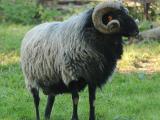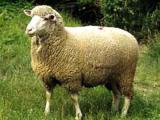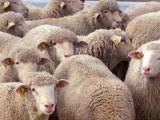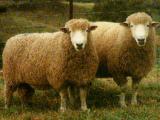
|
Gansu Alpine Finewool SheepThe Gansu Alpine Finewool was one of a number of finewool breeds in China which made use of Xinjiang Finewool, along with Russian Merino rams in its development. The Gansu Alpine Finewool was initially based on Mongolian and Tibetan ewes and was developed through backcrossing to Merino type, followed by selection. |

|
German Blackheaded Mutton SheepIn 1850, blackheaded meat breeds, such as Leicester, Southdown, and Hampshire were imported from England into Saxony to be crossed with local breeds. Thirty years later, breeding of these sheep started more in Westfalia and Eastern Prussia than in Saxony. The Merinofleischschaf (Merino mutton sheep) was prevalent in Saxony. |

|
German Gray Heath SheepThe German Gray Heath is the symbol of the Lueneburger Heide in Germany. Their ancestors, the Mouflon were at home in Corsica. Single lambs are born in spring with a curly, black fleece. After the sheep’s first yearly shearing, its wool turns silver gray with a black bib. Head and legs are black and free of wool. Rams weigh up to 80 kg (176 lbs) and have imposing horns that curl close to the face. Ewes weigh about 45 kg (100 lbs) and have short horns. |

|
German Merino SheepIn the 18th century, Southern German Landsheep were crossed with French and Spanish Merinos, which produced the Merinolandschaf. This sheep breed is the most wide-spread one in Germany today, with 40% of the total German sheep population. The Merinolandschaf of today started with the dual- coated Zaupelschaf, which already in 1539 was not liked because it produced inferior wool. For that reason it was crossed with the Marschschaf from the Lower Rhine. |

|
German Mutton Merino SheepThere are three German Merino breeds: Merinolandschaf (Merino landsheep), Merinofleischschaf (Merino mutton sheep), and Merinolangwollschaf (Merino longwool sheep). Although all three breeds produce Merino wool and are similar in meat yield, they went through a different historical and genealogical development. The Merinofleischschaf is at home east of the Elbe river, spreading all the way to the Ural Mountains. |

|
German Whiteheaded Mutton SheepThis breed was developed along the North Sea coast in the middle of the last century. English Leicester, Cotswold, Hampshire, and Oxfordshire were imported and crossbred with the local Wilstermarschschaf, a northern German marsh sheep. Breeders succeeded in retaining the wanted qualities of the marsh sheep, such as high fecundity, fast development, and large size. In the 1930’s, a new breed, the Deutsches Weißköpfiges Fleischschaf started to roam the grassy areas next to the North Sea. |

|
Gotland SheepGotland sheep were first established on the large Baltic island of Gotland, off the east coast of Sweden. The Vikings brought Karakul and Romanov sheep back from Russia and crossed them with native landrace sheep, such as the Gute. Gotlands are polled. They have short, hair-tipped tails and do not require crutching. |

|
Greyface Dartmoor SheepThe Greyface Dartmoor is also known as the Dartmoor or "Improved" Dartmoor. Descended from the local breeds, which grazed the low ground in and around Dartmoor, they have immense strength of constitution developed through withstanding the severe winters and exposed conditions, which exist around the Moor. Improvements were carried out during the 19th century using the local Longwools (Notts) and the Leicester. |

|
Growmark SheepDevelopment of the Gromark began in 1965 in northern New South Wales, Australia. The Gromark is fixed at approximately 50 percent Corriedale and 50 percent Border Leicester. It is a dual-purpose sheep which evolved from objective selection for high growth rate and fertility with final selection being based on visual criteria: wool quality, frame, and carcass attributes. |

|
Gulf Coast Native SheepSpanish sheep first arrived in Florida in the 1500's. Later importations of Spanish and other breeds of sheep mixed with the earlier population, all evolving under the strong natural selection of the native range conditions of Florida and the other Gulf Coast states. Today a remnant of this population survives and is known as the Gulf Coast. |

|
Gute SheepGute sheep are the most primitive breed in the collection of breeds that make up the Swedish Landrace breed group. These breeds belong to the North European Short Tailed Breeds and are related to such breeds as the Finnsheep, Romanov, Spelsau, Shetland, Faroe, Orkney, and Icelandic sheep. |